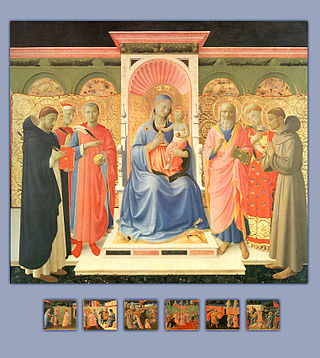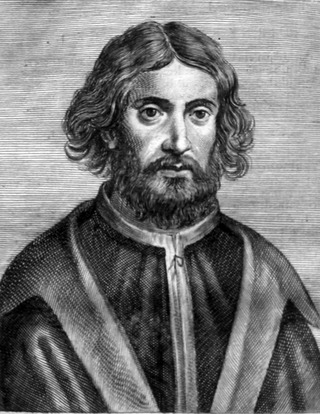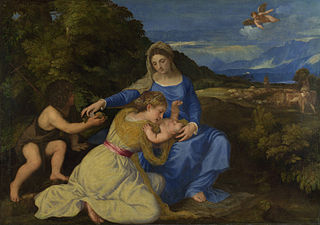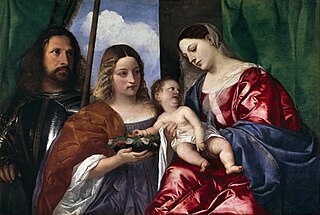Madonna and Child with Three Saints may refer to:
Madonna and Child with Three Saints may refer to:

Giovanni Bellini was an Italian Renaissance painter, probably the best known of the Bellini family of Venetian painters. He was raised in the household of Jacopo Bellini, formerly thought to have been his father, but now that familial generational relationship is questioned. An older brother, Gentile Bellini was more highly regarded than Giovanni during his lifetime, but the reverse is true today. His brother-in-law was Andrea Mantegna.

Lorenzo Lotto was an Italian Renaissance painter, draughtsman, and illustrator, traditionally placed in the Venetian school, though much of his career was spent in other north Italian cities. He painted mainly altarpieces, religious subjects and portraits. He was active during the High Renaissance and the first half of the Mannerist period, but his work maintained a generally similar High Renaissance style throughout his career, although his nervous and eccentric posings and distortions represented a transitional stage to the Florentine and Roman Mannerists.

BartolomeoMontagna was an Italian Renaissance painter who mainly worked in Vicenza. He also produced works in Venice, Verona, and Padua. He is most famous for his many Madonnas and his works are known for their soft figures and depiction of eccentric marble architecture. He is considered to be heavily influenced by Giovanni Bellini, in whose workshop he might have worked around 1470. Benedetto Montagna, a productive engraver, was his son and pupil and active until about 1540. He was mentioned in Vasari's Lives as a student of Andrea Mantegna but this is widely contested by art historians.

Carlo Crivelli was an Italian Renaissance painter of conservative Late Gothic decorative sensibility, who spent his early years in the Veneto, where he absorbed influences from the Vivarini, Squarcione, and Mantegna. He left the Veneto by 1458 and spent most of the remainder of his career in the March of Ancona, where he developed a distinctive personal style that contrasts with that of his Venetian contemporary Giovanni Bellini.

Alessandro Bonvicino, more commonly known as Moretto, or in Italian Il Moretto da Brescia, was an Italian Renaissance painter from Brescia, where he also mostly worked. His dated works span the period from 1524 to 1554, but he was already described as a master in 1516. He was mainly a painter of altarpieces that tend towards sedateness, mostly for churches in and around Brescia, but also in Bergamo, Milan, Verona, and Asola; many remain in the churches they were painted for. The majority of these are on canvas, but a considerable number, including some large pieces, are created on wood panels. There are only a few surviving drawings from the artist.

Benvenuto Tisi, also known as Il Garofalo, was a Late-Renaissance-Mannerist Italian painter of the School of Ferrara. Garofalo's career began attached to the court of the Duke d'Este. His early works have been described as "idyllic", but they often conform to the elaborate conceits favored by the artistically refined Ferrarese court. His nickname, Garofalo, may derive from his habit of signing some works with a picture of a carnation.

In art, a sacra conversazione, meaning "holy conversation", is a genre developed in Italian Renaissance painting, with a depiction of the Virgin and Child amidst a group of saints in a relatively informal grouping, as opposed to the more rigid and hierarchical compositions of earlier periods. Donor portraits may also be included, generally kneeling, often their patron saint is presenting them to the Virgin, and angels are frequently in attendance.

Giovanni Battista Cima, also called Cima da Conegliano, was an Italian Renaissance painter, who mostly worked in Venice. He can be considered part of the Venetian school, though he was also influenced by Antonello da Messina, in the emphasis he gives to landscape backgrounds and the tranquil atmosphere of his works.

The Pesaro Madonna is a painting by the late Italian Renaissance master Titian, commissioned by Jacopo Pesaro, whose family acquired in 1518 the chapel in the Frari Basilica in Venice for which the work was painted, and where it remains today. Jacopo was Bishop of Paphos, in Cyprus, and had been named commander of the papal fleet by the Borgia pope, Alexander VI. This painting recalls one of Titian's earliest paintings Jacopo Pesaro being presented by Pope Alexander VI to Saint Peter, c. 1510-11

The Madonna dell'Orto is a church in Venice, Italy, in the sestiere of Cannaregio. This was the home parish of Tintoretto and holds a number of his works as well as his tomb.

Girolamo da Santacroce was a 16th-century Italian painter of the Renaissance period, active mainly in Venice and the Venetian mainland.

Palma Vecchio, born Jacopo Palma, also known as Jacopo Negretti, was a Venetian painter of the Italian High Renaissance. He is called Palma Vecchio in English and Palma il Vecchio in Italian to distinguish him from Palma il Giovane, his great-nephew, who was also a painter.

The Aldobrandini Madonna is an oil painting on canvas by Titian, dating to around 1530 and now in the National Gallery, London. There are studio copies in the Galleria Palatina in Florence and in the Kunsthistorisches Museum in Vienna.

The Virgin and Child with Saints Dorothy and George is a c.1516 oil on panel painting by Titian, now in the Prado Museum in Madrid, to which it was transferred in 1839.
Madonna and Child with Saints is a common theme in Christian art, and is thus the title of a number of works.

Madonna and Child with Four Saints or Madonna and Child with Saints John the Baptist, Paul, Mary Magdalene and Jerome is a c. 1516-1520 oil on panel painting by Titian, now in the Gemäldegalerie in Dresden. It belongs to the sacra conversazione genre and features saints John the Baptist, Paul, Mary Magdalene and Jerome.

The Virgin and Child with Saints Stephen, Jerome and Maurice, also called the Virgin with Three Saints, is a religious painting by Titian which hangs in the Kunsthistorisches Museum in Vienna.

The Virgin and Child with Saints Stephen, Jerome and Maurice, also called the Virgin with Three Saints, is a religious painting by Titian which hangs in the Louvre in Paris.
Virgin and Child with Saints Stephen, Jerome and Maurice may refer to: